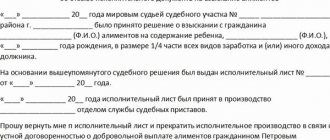By sending a writ of execution to the FSSP department, you have the right to count on quick debt collection or execution of other court orders. However, if this document is lost, it will be impossible to make any demands. The ability to achieve recovery will depend on when and under what circumstances the writ of execution was lost.
What is a writ of execution
A writ of execution is a document that is drawn up on the basis of a court decision made in favor of the plaintiff, giving the right to forcibly collect from the defendant the obligations established by the court decision.
What else is considered an executive document?
In addition to IL, executive documents include:
- court order (issued based on the results of consideration of the case in a simplified order);
- a notarized agreement containing information about the existence of certain obligations between the parties.
Attention! All of the listed documents can be used to forcefully collect obligations from the debtor and are subject to restoration in the event of their loss.
A writ of execution and a writ of execution - the difference?
A writ of execution is a document issued following the entry into force of a court decision on the collection of documents. Any executive document is the general name of all documents received for forced execution by the FSSP.
The enforcement documents in cases of alimony collection will be:
- After the court makes a decision on alimony, a writ of execution is issued immediately after the decision is made (in terms of alimony, any decision is executed by the judge immediately).
- A court order is also an executive document if the claim for the recovery of child support was considered in a simplified order.
- When the agreement is notarized, the alimony agreement also has the force of a writ of execution, and the document can be presented to the FSSP to force the parent to fulfill the obligations assumed.
Any of these documents is presented to the FSSP for enforcement and collection of alimony, and in case of loss, it can be restored.
What articles of the law regulate the issuance of a duplicate writ of execution?
The issuance of a duplicate IL is regulated by the following legislative acts:
- Code of Civil Procedure of the Russian Federation;
- Agroindustrial complex of the Russian Federation.
Issuance of a duplicate writ of execution in a civil case - Civil Procedure Code
The procedure for issuing a duplicate IL in a civil case is determined by Article 430 of the Code of Civil Procedure of the Russian Federation.
The contents of this article establish:
- the right to issue a duplicate of the IL by the court based on the claimant’s application;
- deadlines for filing an application requesting a copy of the document (before the deadline for presenting the document for execution expires or within a month after establishing the fact of loss of the document by FSSP employees or other officials);
- procedure and terms for consideration of the application (10 days);
- the right of the claimant to appeal the court ruling upon receipt of a refusal to satisfy the request.
Issuance of a duplicate writ of execution by an arbitration court - APC
The procedure for issuing a duplicate IL by the arbitration court is determined by Article 323 of the Arbitration Procedure Code of the Russian Federation.
The contents of this article establish:
Dear readers ! To solve exactly your problem, contact our online consultant on the website. It's free. For any region.
Dear readers ! To solve exactly your problem, contact our online consultant on the website. It's free. For any region.
- the right to issue a duplicate of the IL by the court based on the claimant’s application;
- deadlines for filing an application requesting a copy of the document (before the deadline for presenting the document for execution expires or within a month after establishing the fact of loss of the document by FSSP employees or other officials);
- procedure and terms for consideration of the application (10 days);
- the right of the claimant to appeal the court ruling upon receipt of a refusal to satisfy the request.
Application to the court for the loss of a writ of execution
Restoration, or more precisely, the receipt of a duplicate of the writ of execution, is made to the court at the place of its original issuance.
The application submitted to the court for the restoration of the writ of execution contains the following information.
| No. | Contents of the statement |
| 1 | Information about the recipient of alimony and the payer, their full name, address |
| 2 | Information about the civil case for which the writ of execution was issued |
| 3 | The essence of the decision made by the court (from whom alimony was collected, in what amount, for which children) |
| 4 | Information about the FSSP and the bailiff who conducted the enforcement proceedings |
| 5 | Information about the FSSP and the bailiff who conducted the enforcement proceedings |
| 6 | Request to the court to issue a duplicate sheet |
The application must be signed by the applicant. Also, evidence or testimony must indicate that the document is lost. Confirmation may be a certificate from the FSSP about the loss or explanations from third parties, such as an employer.
The application will be examined at the court hearing. To do this, the parties are invited to court, and their appearance is not obligatory, but it is recommended to defend their position if there is insufficient objective evidence. At the end of the hearing, the decision is announced.
The requirement to issue a duplicate of the writ of execution is not subject to duty. The court will be able to make a decision on issuing a copy without paying a state fee from the applicant. But the claimant must restore the documents and no one will return the money lost during this period or the money spent.
What could be the reasons for the loss of writs of execution?
The following reasons for the loss of IL are possible:
- Due to the fault of the postal service. If documents are lost during shipment, you can file a claim at the post office. If you cannot find the letter, you should take steps to prepare a duplicate document. Proof of loss can be a receipt for payment for postal services.
- Through the fault of an FSSP employee. If the writ of execution is lost by the bailiff before the commencement of proceedings, the claimant will have to draw up a duplicate. Evidence of the loss of a document can be a notification, which in such cases the bailiffs are required to send to the recoverer. A fine may be applied to the official responsible for the loss.
Attention! If the writ of execution is lost by FSSP employees during the proceedings, the claimant does not have to independently restore it. A bailiff can go to court and get a duplicate of the IL.
Loss of a writ of execution in the FSSP - the bailiffs lost the writ of execution
The fact of loss of IL by bailiffs is detected under the following circumstances:
- familiarization of the claimant with production materials;
- a documentary check carried out by the management of the FSSP or employees of the prosecutor's office;
- familiarization of the court with the materials of proceedings during the consideration of complaints regarding the actions or inaction of bailiffs;
- transfer of documents from one bailiff to another.
If it is discovered that a writ of execution is missing from the case file, the claimant is immediately sent a corresponding notification with a proposal to take measures to restore it. The bailiff himself has the right to submit an application to the court with a request to issue a duplicate.
Attention! Loss of IL is not grounds for termination of proceedings and removal of obligations from the defendant. After receiving a copy of the document, enforcement action should continue.
Emergency
In rare cases, a writ of execution may be lost due to an emergency, such as a fire. Under these circumstances, the following may be provided to the court as evidence:
- certificate of incident;
- documents confirming the fact of damage incurred;
- Commission report on the results of the inspection of the damaged premises.
These certificates are not direct evidence of the loss of a document as a result of an emergency. However, they can confirm the veracity of the applicant's words.
The writ of execution was lost while being sent by mail
The most common reason for the loss of a writ of execution is loss during mailing. If the sender was the bailiff service, the responsibility for restoring the document rests with its employees, namely officials of the department that was responsible for sending it.
If the sender was the collector, he will have to deal with this issue independently.
Claimant's carelessness
If the IL is lost by the claimant due to his own carelessness, evidence of this fact may vary depending on the circumstances. For example, if a document was in a bag or briefcase that was stolen, you can provide the court with a copy of the statement filed with law enforcement to confirm this incident.
The debtor's employer lost the writ of execution
If the writ of execution was sent to the debtor’s place of work, responsibility for its safety rests with the payer’s employer. In the event of loss, a corresponding notification is sent to the claimant or bailiffs, after which the claimant must take measures to restore it. The notice received from the debtor's employer is provided to the court as evidence.
Attention! The loss of a writ of execution should in no way affect the regularity of deductions of debt amounts from the debtor’s wages in favor of the claimant.
The bank lost the writ of execution
After receiving the writ of execution, the bank is obliged to forcibly write off the amount specified in the documents from the debtor’s account in favor of the claimant. If there are no funds in this account, the IL is stored in the financial institution until it is fully executed or withdrawn.
If it is lost, the bank must notify the claimant in writing and provide him with a certificate confirming this fact. When applying to court, the following can be attached to the application as evidence:
- certificate or notification from the bank;
- written confirmation of the absence of IL for execution, received from bailiffs.
Attention! If, due to the loss of the IL, the requirements specified in it were not fulfilled, and subsequently the possibility of withholding the amounts of obligations from the debtor’s account was lost, the claimant has the right to file a claim in court for compensation by the bank for the losses incurred by him.
Procedure
The basis for restoring a lost or damaged writ of execution is the claimant’s application submitted to the same court that previously issued a decision on alimony. After this petition is completed, the judge will set a date and time for a new hearing. The presence of the claimant at the hearing is desirable, but not required. If a person is absolutely sure of the set of documents with which he will support the submitted application, then he does not have to be present in the courtroom.
Drawing up an application
An application for the restoration of a writ of execution is drawn up in the same way as an earlier application for the issuance of an original document, with the only difference that now the person will need to ask not for the original, but for a duplicate. Here you must provide the following information:
- Information about the claimant, alimony payer and third parties (full name, registration and actual residence addresses, contacts).
- Information about the court case and the court decision in accordance with which the writ of execution was issued.
- Circumstances of loss.
- Facts confirming the loss.
- Information about the official, if the writ of execution was lost due to his fault, and the organization in which he is registered (department of the bailiff service, employer company, etc.).
- Request for a duplicate.
- List of applications.
- Date and signature of the applicant.
The application will need to be supported by copies of materials that confirm that the claimant’s fault for the loss of the writ of execution was either absent altogether or was minimal. We are talking about:
- a certificate from an official confirming negligence in the workplace;
- a postal receipt or receipt indicating the fact of delivery of the writ of execution to the official;
- a bailiff's order to initiate enforcement proceedings against a specific debtor;
- a certificate from law enforcement agencies stating that a statement regarding the theft of a writ of execution was accepted for consideration;
- testimony of witnesses about the unintentionality of the loss or damage of a valuable document by the claimant himself.
Recovery time
The date of the hearing is set within 10 days after the court clerk accepts and registers the application for the issuance of a duplicate writ of execution. In addition to the plaintiff and defendant, persons involved in the loss of a valuable document may be involved in the hearing - these are:
- bailiff;
- an accountant who calculated the wages of the alimony payer and interacted with the original;
- employees of other organizations.
A document can only be restored if it is known that the previous original would still be valid at that point in time. You cannot receive a duplicate if the validity period of the original has expired. As a general rule, the claimant has the right to demand the restoration of the current writ of execution until the child reaches 21 years of age (i.e., the statute of limitations here is calculated using the formula “majority + 3 years on top”).
Parents have the right to provide materials justifying them and not be present at the hearing if they notify the judge at least 3 days before the hearing. But the official accused of involvement in the disappearance of the writ of execution will still need to come to the courtroom. Failure to appear will not relieve him from having to bear the lawful penalty if it is imposed.
Ending the process
If the request for restoration of the writ of execution is granted, a completed duplicate will await the claimant in the court office. In case of refusal, the person will be able to initiate an appeal procedure within 10 days from the date of the relevant decision. The appeal is first filed with the same court that issued the previous verdict, and if the petition is not satisfied again, it is filed with a higher court of second instance.
Upon receiving a duplicate of the writ of execution, the claimant himself decides what to do next. If the debtor regularly fulfills the alimony obligations assigned to him, the recipient has the right to simply keep the document at home. The writ of execution can again be sent either to the bailiff service, or directly to the accounting department, which calculates the wages of the alimony payer, or to the Pension Fund, which pays a pension to the second parent, etc.
Restoring a writ of execution is an individual legal procedure that has its own characteristics in each specific case. To obtain a duplicate, you will need to collect a sufficient number of papers and certificates that can confirm that the loss or damage of a valuable document was unintentional and accidental. A professional lawyer will help his client not only acquire the necessary evidence base, but also, as a result, win the court on his side.
FREE CONSULTATIONS are available for you! If you want to solve exactly your problem, then
:
- describe your situation to a lawyer in an online chat;
- write a question in the form below;
- call Moscow and Moscow region
- call St. Petersburg and region
Save or share the link on social networks
- FREE for a lawyer!
Write your question, our lawyer will prepare an answer for FREE and call you back in 5 minutes.
By submitting data you agree to the Consent to PD processing, PD Processing Policy and User Agreement
Useful information on the topic
1
Application to the prosecutor's office for non-payment of alimony
Alimony payments help a single mother or father stay afloat, support...
Indexation of alimony
Due to the fact that prices are constantly rising, in some...
1
Minimum amount of child support
There is not a single clause, regulation or clarification in the legislation that...
2
Can a father or mother file for child support for their son?
Parents who have cared for their children in their later years have the right...
7
Receipt for receipt and payment of child support
Alimony can be transferred to the recipient in any convenient way, the legislation in this...
2
Court order for the collection of alimony
The rules for collecting alimony starting in 2021 have changed somewhat and...
The procedure for obtaining a duplicate of a writ of execution in court
To obtain a duplicate of the writ of execution, the applicant will need to provide evidence that the document was actually lost and the court decision was not executed or partially executed.
The following can be used as evidence:
- a certificate from the FSSP confirming the absence of IL in the production materials;
- a certificate from the bailiff service stating that they did not receive the writ of execution and that proceedings were not initiated on it;
- notification from the bank about the absence of IL;
- documents confirming the fact of sending the writ of execution to the FSSP department or other organization.
To obtain a duplicate, you need to fill out an appropriate application. The application should be submitted to the judicial authority that made the decision, namely:
- magistrate or district court;
- arbitration court;
- court of general jurisdiction.
Attention! The deadline for filing the IL is restored provided that the collection period for it has not yet expired.
What to do if the writ of execution is lost and how to restore it
In order to restore the writ of execution, it is necessary, within the period established by law, to submit an application to the judicial authority that issued the decision, attaching to it all available evidence of the fact of the loss that occurred. The case is being considered in court, so the claimant is recommended to appear at the hearing and wait for the results of the proceedings, and then receive the appropriate determination.
If a refusal is received and disagrees with the court decision, the applicant has the right to challenge the ruling in the manner prescribed by law. If the court has granted the request, all that remains is to obtain the requested duplicate from the court office.
Deadline for filing a petition with the court
An application requesting the issuance of a duplicate writ of execution can be submitted to the court before its expiration, i.e. within 3 years from the date of the court decision.
If the document is lost by the bailiff, the claimant has the right to go to court within 30 days after receiving information about the fact of the loss, even if the validity period of the document has expired. The court will need to provide confirmation of the date when the claimant became aware of the loss.
How to draw up and what should contain an application for a duplicate writ of execution
During the trial, questions regarding whether the document was destroyed intentionally or lost due to negligence are not considered. In this case, the only thing that matters is whether the applicant can prove the fact of the loss itself. This should be given special attention.
Reference. The loss of a writ of execution also means making the document unreadable.
The application must be made in writing. Its content should indicate:
- data of the claimant and the defendant;
- information about the court decision, its details;
- the essence of the claims;
- information about the bailiff responsible for the execution of the court decision;
- description of the circumstances of the loss of the document;
- request for a duplicate.
Application for issuance of a certificate of loss of a writ of execution
Sample application for the issuance of a duplicate writ of execution in connection with loss
To obtain a duplicate, you must fill out an application for a copy of the writ of execution. A sample of it is below.
The procedure for considering an appeal and issuing a duplicate sheet in court
After receiving an application for the issuance of a duplicate of the IL, the judge sets a date for the court hearing, where all participants in the process are invited. The applicant is advised to attend the meeting. Thus, he can describe in detail all the circumstances of the incident and justify his claims.
Attention! The absence of the parties at the court hearing is not a reason for refusing to issue a duplicate.
At the end of the trial, the judge issues a ruling, which, if necessary, can be appealed in accordance with the procedure established by law.
Deadlines for issuing a duplicate writ of execution
The period for consideration of the application in court and making a decision on issuing a duplicate of the IL is 10 days. After the determination is made, you must wait for the document to enter into legal force. This period is 15 days. Upon completion, you can obtain a copy of the IL and transfer it to the FSSP.
Responsibility for the loss of a writ of execution
The main difficulty is that when applying again, the claimant cannot receive either the original or a copy of the writ of execution for alimony. Only the issuance of a duplicate is permissible, but it will have the same full legal force as a lost or damaged original. It will be necessary to initiate the procedure for restoring the writ of execution as soon as possible, because for the period of absence of the document, the payment of alimony will be terminated legally. Alimony legal relations between the parties will be resumed only after the writ of execution is restored. In this case, the debt for the missed time will not accumulate.
What matters is who exactly caused the paper to be lost. The culprit may be:
- the claimant himself;
- official (bailiff/accountant of the company where the debtor works/employee of the post office responsible for sending a valuable letter/employee of the Pension Fund of Russia or another organization).
The situation is simplified when the alimony recipient is to blame for the loss or damage of the document - in this case, he will not have to collect a lot of third-party papers. For loss, the state duty will not even be withheld from it, because... it has been abolished since 2013! However, this does not mean that in the future the claimant will be able to be negligent about the safety of the writ of execution. If a person requests the issuance of duplicates too often, the court may simply cancel the order to withhold alimony. To restore a document that was lost in everyday life, it will be necessary to involve witnesses in the case who can describe the circumstances of the loss of the writ of execution.
The matter becomes significantly more complicated when an official is to blame for the loss or damage of the writ of execution. In this case, the claimant will be required to obtain a certificate indicating that this fact occurred precisely through the fault of the authorized employee. As practice shows, officials (bailiffs, company accountants, etc.) do not always want to admit their own mistakes, because for negligence in the workplace they can be held administratively liable and have to pay a fine of 2,000 to 5,000 rubles. Therefore, they may deliberately delay issuing a certificate. All this time, the claimant will not only not receive deductions for the child, but may also suffer unexpected losses. If the official is unwilling to make contact and issue a certificate of the loss of the writ of execution, a family law lawyer will be able to help the alimony collector. Here you will need to use various levers of pressure on the negligent employee - this includes contacting his superiors, the police, and other authorities.
Not only the claimant, but also the alimony payer should be interested in restoring the writ of execution. The fact is that in some cases, the loss of a document may be regarded by the court as an attempt to avoid parental responsibilities. For this, criminal liability measures may be applied to the debtor.
The writ of execution may be stolen. In this case, the claimant will need to contact the police station, where they will file a statement to initiate a case regarding the theft. Even if law enforcement agencies fail to fully prove the involvement of a particular person in an offense, the recipient of alimony will need to provide the court with any certificates and police reports indicating that the writ of execution disappeared through no fault of his own. Otherwise, a person risks being refused to restore the document and losing the right to withhold funds from the second parent in favor of a minor child.
We recommend reading: Payment of alimony without a writ of execution
Refusal to issue a duplicate writ of execution - possible reasons
To obtain a copy of the personal identification document, it is important for the claimant to prove in court the fact of its loss. This is necessary to eliminate the possibility of fraud.
The writ of execution is issued to the plaintiff in a single copy. The document can be submitted to the FSSP, bank or employer of the debtor for the purpose of forced collection of debt. If the claimant succeeds in fraudulently obtaining a duplicate of the IL while he has the original, he will be able to submit both documents to different organizations. As a result, the debtor may be deducted double the amount of obligations. In order to suppress such actions, the court imposes strict requirements on the availability of evidence of the fact of the loss.
Refusal to issue a copy of the writ of execution is possible for the following reasons:
- lack of convincing evidence of the loss;
- presence of errors in the claimant's application;
- distortion of data or indication of knowingly false information in submitted documents.
Step-by-step instructions for restoring a writ of execution
Of course, the loss of such a document is fixable. However, the claimant will have to spend a lot of his time and effort to restore the sheet. Of course, the deadlines provide an opportunity to wait, but it is important that during this period the minor child must have a means of subsistence, because collection of funds will be possible only after the proceedings are resumed.
Step-by-step instructions for obtaining a writ of execution to collect alimony from a defaulter are as follows:
- First of all, the interested person must contact the authorized government agency that issued the lost document. As a rule, this is a court. If the parties have entered into a voluntary agreement to pay alimony, it can be restored at a notary’s office. You need to contact the specialist who certified the original documents, since at the moment the notary does not have the authority to issue documents not certified by him. However, it is planned that such an opportunity will appear in the near future, since a unified electronic document database is now being introduced and tested.
- When submitting documents, the applicant must prove the fact that the original writ of execution was actually lost. In this situation, the most difficult thing is to prove the fact that the document was lost through no fault of the claimant. To do this you need to provide certificates. To obtain evidence, you can contact a lawyer who can prove that the loss of documents occurred due to the fault of a bailiff or an official in the organization of the second parent.
- Based on the results of reviewing the documents, the judge makes a decision on the need to issue a duplicate of the writ of execution.
The consideration of such an application takes place in the order of a court hearing, at which the claimant and the alimony payer do not have to be present. However, the specialist is recommended to still be there or send his representative, who can substantiate all aspects of the case that have legal significance.
Please note that Russian legislation is constantly changing and the information we write may become outdated. In order to resolve a question you have regarding Family Law, you can contact the site’s lawyers for a free consultation.
What to do to prevent the loss of a writ of execution
To avoid losing the writ of execution, it is recommended to adhere to the following tips:
- Make a scan or copy of the IL.
- When submitting a document to the FSSP, the bank or the debtor’s employer, provide the responsible official with a copy of it to put a mark on it indicating receipt of the original.
- If documents are submitted by post, it is recommended to send them by a valuable letter with an inventory of the contents and delivery notification. The receipt for postage must be retained.
- Do not give the original writ of execution to the debtor to familiarize himself with its contents. If the need arises, it is recommended that you submit a copy.
What to do if the writ of execution was lost by the bailiff
Unfortunately, in practice there are quite often situations when the writ of execution, on the basis of which alimony payments for the maintenance of a minor are collected, is lost by bailiffs and accountants. What to do in this situation?
Of course, first of all, a person who has suffered from such actions of an official must file a complaint. The law provides for liability for such negligence of an employee, a fine under this article is up to 5 thousand rubles.
In such a situation, the judge may decide to issue a duplicate of the writ of execution without the applicant paying a state fee, since the loss of the document was not the fault of the claimant. However, a person will have to restore the sheet on his own, that is, no one will be able to compensate him for wasted time or travel expenses to government agencies.
Often, bailiffs and accountants in organizations, fearing liability, refuse to issue a certificate of loss of the writ of execution. The only way to achieve justice is to contact a specialized lawyer who understands these issues and can defend the interests of his client for the right to receive a document to collect alimony.










